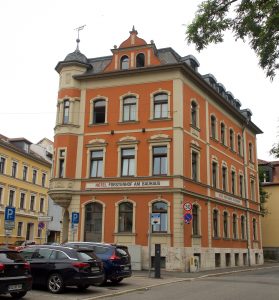
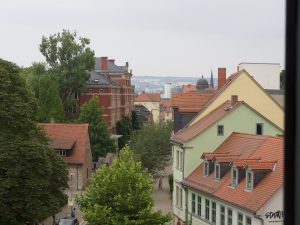
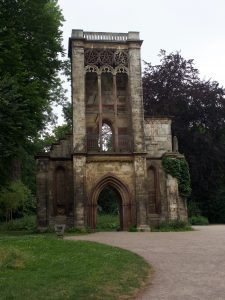
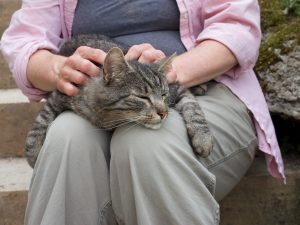
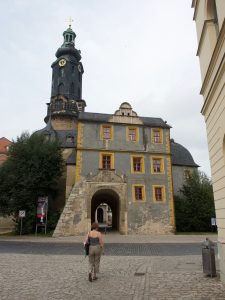
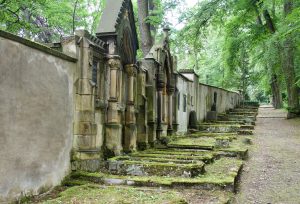
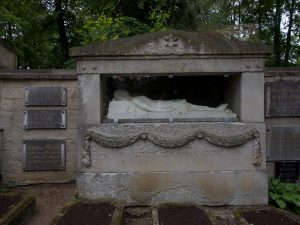
We got up early (before 6:30) and I walked with Loisi (as it turns out, a pet name / diminutive of Aloisia—I had been wondering about that) to the bakery and we picked out some rolls for our breakfast and lunch sandwiches. We got back to the house at about 6:45, and I had a pretty hurried breakfast while also making our sandwiches before Michl picked us up at 7:15. He drove us to a nearby train station from which we could catch a regional train to our actual connection, and since we also had two additional stopovers, our train trip ended up being: Attnang – Wels; Wels – Nürnberg; Nürnberg – Erfurt; Erfurt – Weimar, all between 8 am and 3 pm. Throw in a delay after Nürnberg that had us looking for a new Erfurt-Weimar connection, and a long walk from the Weimar train station to our hotel, and it was a fairly complex travel day, given our big suitcase. But the scenery en route was very pretty, we got a few naps in, and although the cobblestones of Weimar were not our friend, we did make it to the hotel ok. The trend of “Antje and Mark get put in the room at the very top under the roof” continues from Geneva and Zurich, and by 4 pm, we had settled in an enormous suite with kitchen (although it’s the cheapest hotel on our trip so far) on the top floor of the Fürstenhof am Bauhaus in Weimar, a nicely renovated 4-story Victorian with a beautiful view, but very strange and useless wifi and NO elevator.
It was a little cooler here and overcast, but that was actually welcome relief after all the hot weather we had in Austria. Since I know Weimar from a previous trip in 2009 with my friend Uschi, I knew fairly well where we were after a glance at the map, and showed Mark around—the hotel is only a block from one of the main pathways into the park at the river Ilm. I love this park, and we rambled around exploring the various funky features, like the now-picturesque ruin of a building that was left partly standing after an allied bombing in 1945, or the various statues of Liszt and Shakespeare, the Roman villa and Goethe’s garden house, and we even went into the “Park Cave” (really a system of underground tunnels that were initially dug for a beer brewing operation in Goethe’s time, but then repurposed as a bomb shelter in WWII. There are a few spots where the geology of the region is visible in the cave, and there are also some fossils that were actually dug out and catalogued partly under Goethe’s oversight. But the cave was a bit of a disappointment, while the park was gorgeous and a lot of fun. Nonetheless, the highlight was probably finding a cat who REALLY REALLY wanted to be petted for a little.
Actually, the park in Weimar is wonderful, and I fell in love with it in 2010. It is one of the first parks that was designed to just invite people to stroll and contemplate various spots, and if I am not mistaken, it was designed from the beginning to be open to the public, even though the land belonged to the Karl August, the famous ruler (Grand Duke of Saxe-Weimar-Eisenach, to be precise) who brought Goethe and so much amazing culture and art to Weimar in the late 18th and early 19th century (after his mom had already gotten started with the now world-famous library). I tried to give Mark a quick sketch of why this man and his buddy / semi-tutor / high-level civic servant Goethe were so famous and influential—but it’s pretty hard to put that in a nutshell. Maybe the only way to encapsulate it is to point out that there are EIGHT world heritage sites right here within a couple of square miles, and then three more in the outlying areas.
We then walked from the park to the historic city center and wandered around the beautifully preserved 18th century and older homes. The plazas in Weimar are especially pretty—very old cobblestones and nice big spaces between the buildings giving way to crooked little alleys like everywhere else. We strolled around pretty much all the famous spots—the palace that so obviously was a funky little castle before the palace was added in the late 18th century; the houses where Goethe and Schiller lived, the Wittumspalais, where Karl August’s mother, Anna Amalia, lived as the dowager duchess after he was old enough to rule, and the national theater with the statue of Goethe and Schiller in front of it. Then we found ourselves some super cheap (and bad) Asian food and ate it at the foot of the Goethe-Schiller monument, watching skateboarders practice their moves and high schoolers doing a sort of Weimar scavenger hunt. We had gelato for the dessert, but our portions were huge and we actually left some in our dishes, which never happens. We strolled around a bit more and found our way back to our hotel; it was a pretty quiet night in town (probably because it was Monday and the museums were mostly closed), and we were pretty tired. So we only explored one more thing right by our hotel, namely the historic cemetery (which I hadn’t seen last time I was here). That was pretty cool, because the old, broken-down, moss-covered graves were really interesting to look at. Many had grave plaques on a wall (some legible, some not) rather than on the ground, and much of the cemetery looked very unkempt in a very romantic and appealing way). We looked at the Goethe family plot (I liked that it included a favorite servant) and walked around the improbable Russian orthodox chapel and mausoleum that was built for Maria Pavlova, wife of a 19th century grand duke, in the middle of the cemetery at the back of the family crypt. We couldn’t go in because of renovations, but just seeing the outside, with little gold onion domes etc., was quite interesting.
Our last heroic act for the day was to climb the three floors to our rooms, and now we are just enjoying having this much space in hotel accommodations—a kitchen, a living room, a bed room, and a total of five windows.